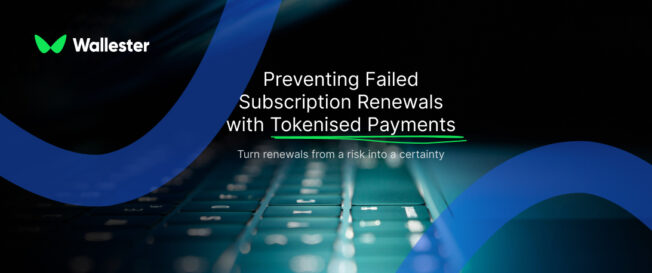Subscriptions have become the standard way businesses access software and digital services. Monthly and annual billing make it simple to adopt new tools, but this flexibility also creates a quiet vulnerability. When a payment fails, access is immediately cut off. Teams lose critical functionality, finance staff scramble to fix issues, and suppliers risk losing revenue. Across the UK and Europe, where companies now manage hundreds of SaaS contracts, the problem of failed renewals is a growing concern. Tokenised payments are emerging as one of the most effective ways to address it.
Why do subscription renewals fail?
Most failed renewals are caused by payment problems, not by a deliberate decision to cancel. The most common reasons include:
- Expired cards. Standard corporate cards have fixed expiry dates, and renewals often fail when the new details have not yet been updated.
- Card re-issuance. If a card is lost, stolen, or replaced due to suspected fraud, the old number becomes invalid, which breaks any recurring payments tied to it.
- Outdated billing information. Changes to your address or billing details may result in automated declines.
- Bank declines. Security checks or insufficient funds occasionally stop otherwise valid payments.
The result is a service interruption. A team relying on a design tool may find itself locked out of projects; a retailer could lose access to its payments gateway; an agency might miss a reporting deadline because analytics software shuts down mid-cycle. These are not minor inconveniences – they can damage productivity, client relationships, and revenue.
Further Reading: The Ultimate Guide to Managing SaaS and Subscription Spend
The hidden cost of failed renewals
Failed renewals incur costs in ways that are not always reflected on the balance sheet.
- Lost productivity – every hour staff cannot access essential software is an hour wasted. For teams that depend on SaaS, even brief outages can disrupt work.
- Administrative burden – IT and finance departments spend time chasing failed invoices, contacting suppliers, and updating card details.
- Late fees and penalties – some vendors impose charges if payments fail repeatedly.
- Strained supplier relationships – vendors lose trust when payments appear unreliable, which may limit flexibility during negotiations.
Research finds that businesses lose 20-40 % of subscriber revenue to involuntary churn, primarily caused by failed payments. For B2B organisations, the parallel is clear – each failed renewal disrupts operations and introduces unnecessary financial loss.
What are tokenised payments?
Tokenised payments replace sensitive card details with a unique, secure token. Instead of storing the actual card number, the system generates a randomised string that represents the account. This token can be used for future transactions but has no value outside its authorised context.
Key points about tokenisation:
- It improves security, as real card details are never exposed during transactions.
- It supports compliance, particularly with PCI DSS requirements.
- It increases continuity because the token remains valid even if the underlying card is replaced or reissued.
For recurring payments, such as SaaS subscriptions, tokenisation ensures that billing continues smoothly in the background. The vendor charges the token, and the payment network automatically maps it to the updated card details.
Further Reading: The Leading Corporate Spending Trends in 2026
How tokenised payments solve renewal failures
Traditional card-on-file systems break down when a card expires or is replaced. Tokenisation removes this fragility.
- Automatic updates
When a card is reissued, the token remains active and automatically linked to the new account. No need to manually update every subscription.
- Continuity of service
Recurring payments go through seamlessly, avoiding service interruptions.
- Compatibility
Supported by major card networks (Visa, Mastercard, American Express), tokenisation works across borders and currencies.
The scale of the challenge is clear: organisations manage on average 247 SaaS renewals per year. Each renewal is a potential failure point if billing details are outdated. Tokenised payments reduce the risk across every one of these transactions.

Best practices for using tokenised payments in subscription management
Adopting tokenisation means embedding it into the way subscriptions are managed. Best practices include:
- Standardise tokenisation across vendors – make sure every supplier capable of accepting tokenised payments is configured to do so.
- Issue virtual cards per subscription – link each token to a dedicated card, giving clear visibility of spend.
- Set spending controls – define limits per transaction or per month to prevent misuse or unexpected charges.
- Use dashboards and alerts – monitor renewals centrally, with notifications for any irregularities.
- Review regularly – tokenisation prevents failed payments, but renewals still need oversight to confirm services are required and budgets are aligned.
Tokenisation and virtual cards: a stronger combination
Tokenisation on its own keeps renewals active, but when combined with virtual cards it becomes a more powerful framework for managing subscriptions. Virtual cards allow each SaaS service to be assigned its own dedicated payment method. Linking those cards to tokens creates both continuity and accountability.
Key advantages include:
- Clear accountability. Each subscription is tied to a unique virtual card and its token, which makes it easy to identify who approved the spend and which team is responsible for ongoing costs. Instead of dozens of charges appearing on a single corporate card statement, every tool can be traced back to an owner.
- Improved spend visibility. Finance teams gain detailed insight into subscription payments. Reports show how much each team or department spends on software and how those costs evolve over time. This prevents hidden growth in budgets and gives leaders a chance to review usage before renewals occur.
- Faster reconciliation. Virtual card payments flow directly into accounting software, so finance teams spend less time matching invoices manually. Each card corresponds to one vendor, and the token keeps renewals smooth, so transactions can be categorised automatically and linked to budgets with minimal effort.
- Control of shadow IT. Unapproved tools are harder to hide when virtual cards are mandatory. If a team wants to subscribe to a new service, they need an authorised card. This creates a checkpoint where finance and IT can assess the request, preventing small experiments from turning into uncontrolled recurring costs.
Together, tokenisation and virtual cards address two of the biggest pain points in subscription management: unexpected failures and invisible spending. Instead of chasing late invoices or manually updating expired cards, finance leaders see a clear map of their organisation’s software estate. They can plan renewals, negotiate vendor contracts with real data, and focus on long-term strategy rather than firefighting payment problems.
Further Reading: SaaS Subscription Sprawl: How Virtual Cards Keep Costs Visible
Case examples: avoiding disruption with tokenised payments
Retailer example: A UK online fashion retailer lost access to its email marketing platform when the corporate card expired without notice. It took three days to restore service, costing the company thousands in missed campaign revenue. After adopting tokenised payments tied to virtual cards, renewals continued seamlessly through card re-issuance.
Consultancy example: A mid-sized consultancy in Germany relied on over 120 SaaS tools. Card fraud required re-issuance, and dozens of subscriptions failed at once. Moving to tokenisation eliminated the risk, and the firm saved an estimated 400 hours of admin annually.
Multinational example: A European manufacturing group adopted tokenised payments with role-based virtual cards across departments. Finance teams gained real-time visibility into renewals, while suppliers appreciated uninterrupted billing. The change reduced payment failures by over 90% in the first year.
Wallester Business: tokenisation in practice
Wallester integrates tokenised payments directly into its virtual card platform, giving companies a practical way to prevent failed renewals while strengthening overall expense control.
How it works:
Every subscription can be linked to a dedicated virtual card. When tokenisation is activated, renewals continue automatically, even if the underlying card details change. Finance teams monitor spend, with instant alerts for each transaction.

Key features for SaaS-heavy companies:
- Virtual cards issued instantly for each supplier or subscription.
- Full tokenisation support, keeping renewals uninterrupted.
- Real-time transaction tracking and analytics.
- Automatic categorisation of spend for easy reporting.
- Integration with major accounting software.
- Custom limits and expiry settings for precise budget control.
Practical scenarios:
- A marketing team’s analytics tool renews without disruption after a corporate card expires.
- An IT department tracks all infrastructure SaaS costs by assigning tokens to dedicated cards.
- Finance managers receive alerts before renewals, with confidence that payment will succeed.
For organisations across Europe dealing with SaaS sprawl, Wallester Business combines continuity, visibility and control. Instead of reacting to failed renewals, companies stay ahead, saving both time and money.
Conclusion
Failed renewals are more than a minor inconvenience. In fact, they are an operational risk. They disrupt services, waste staff hours, and weaken supplier trust. In a region where businesses handle hundreds of SaaS contracts each year, the potential for failure is too high to ignore.
Tokenised payments address the root cause by keeping billing active even when cards change. Paired with virtual cards, they add visibility and governance. Companies adopting this model gain uninterrupted access to tools, tighter financial control, and stronger supplier relationships. In short, tokenisation turns renewals from a risk into a certainty.



